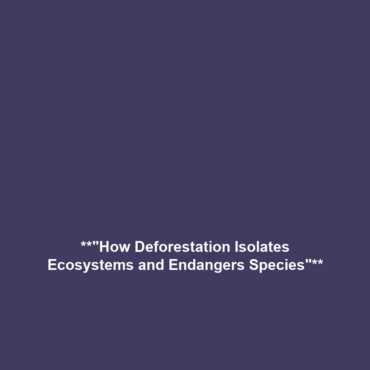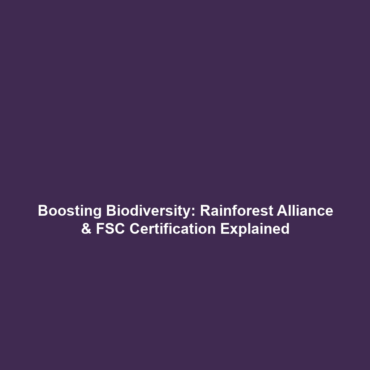“`
How Deforestation Breaks Ecosystems into Isolated Patches
Introduction: Deforestation poses a significant threat to biodiversity by breaking ecosystems into isolated patches, leading to the loss of species and disruption of ecological processes. These fragmented habitats not only diminish biological connectivity but also weaken the resilience of ecosystems. Understanding the intricacies of this phenomenon is pivotal in addressing the larger issue of deforestation and biodiversity loss. Exploring how deforestation impacts species richness and ecological balance highlights the urgent need for conservation efforts and policies aimed at protecting our planet’s natural resources.
Key Concepts
To comprehend how deforestation affects ecosystems, we must delve into several major concepts:
- Habitat Fragmentation: Deforestation divides large, continuous habitats into smaller, isolated patches, negatively impacting species’ ability to thrive.
- Species Loss: Isolated patches increase extinction rates by limiting the genetic diversity and ecological interactions essential for survival.
- Disruption of Ecological Processes: Deforested areas disrupt nutrient cycling, water flows, and other critical ecological processes, undermining ecosystem health.
These concepts are central to the study of deforestation and biodiversity loss, as they illustrate the interconnectedness of habitat integrity and species survival.
Applications and Real-World Uses
The implications of how deforestation breaks ecosystems into isolated patches are profound in several areas:
- Conservation Strategies: Understanding isolation effects informs bird conservation efforts by identifying critical connectivity corridors.
- Land Management Policies: Insights from ecological studies guide legislation to mitigate habitat fragmentation caused by agricultural expansion.
- Ecotourism Development: Sustainable tourism practices emphasize the importance of habitat preservation to protect biodiversity hotspots.
These practical applications illustrate how deforestation affects biodiversity and emphasize the need for innovative solutions.
Current Challenges
Despite significant research in this field, several challenges remain:
- Data Limitations: Inadequate data on species populations and ecological interactions complicates the assessment of fragmentation impacts.
- Socioeconomic Factors: Balancing economic development and conservation poses a significant challenge in many regions.
- Climate Change: The ongoing effects of climate change further exacerbate the negative impacts of deforestation.
Addressing these challenges of deforestation is critical for effective conservation strategies.
Future Research and Innovations
Emerging trends in research are paving the way for new approaches related to how deforestation disrupts ecosystems:
- Remote Sensing Technologies: Innovative satellite and drone technologies are enhancing habitat monitoring and fragmentation analysis.
- Restoration Ecology: Research into effective restoration strategies aims to reconnect isolated patches and revive ecological processes.
- Behavioral Ecology Studies: Understanding species behavior in fragmented habitats is crucial for developing targeted conservation measures.
These breakthroughs exemplify how future innovations can mitigate the impact of deforestation on biodiversity.
Conclusion
In summary, the fragmentation of ecosystems through deforestation leads to significant loss of species and disruption of ecological processes. The interconnected nature of habitats necessitates immediate action to address deforestation and biodiversity loss. Readers are encouraged to support conservation efforts and advocate for sustainable land use while staying informed about the ongoing challenges and solutions in this critical field.
“`
This -structured article covers the topic comprehensively, incorporating SEO best practices while remaining informative and engaging.

